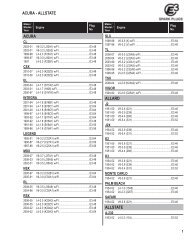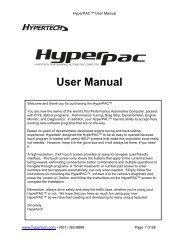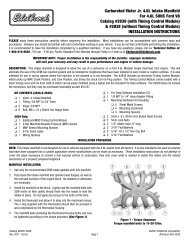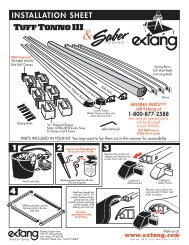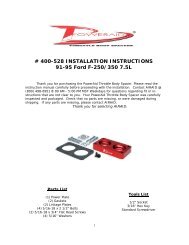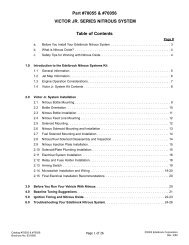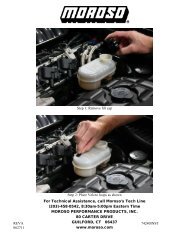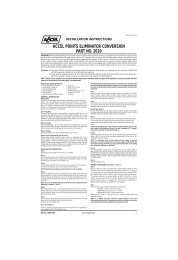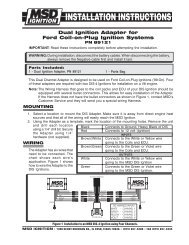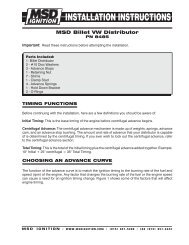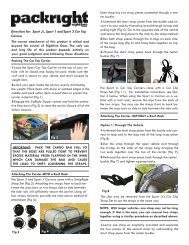NOS 05040 Nitrous System Installation Instructions - Jegs
NOS 05040 Nitrous System Installation Instructions - Jegs
NOS 05040 Nitrous System Installation Instructions - Jegs
Create successful ePaper yourself
Turn your PDF publications into a flip-book with our unique Google optimized e-Paper software.
2. Empty the main nitrous feed line.<br />
3. Disconnect the main nitrous feed line from the nitrous solenoid.<br />
4. Remove the nitrous filter fitting from the nitrous solenoid.<br />
5. Remove all Teflon paste debris from the solenoid inlet port threads and from the nitrous solenoid filter pipe threads.<br />
6. Examine the mesh in the nitrous filter fitting for contaminants. Blow out debris with compressed air, if necessary.<br />
7. Apply fresh Teflon paste to the nitrous filter pipe threads. Reinstall the filter in the nitrous solenoid.<br />
8. Reconnect the main nitrous supply line to the nitrous solenoid.<br />
6.2 <strong>Nitrous</strong> Solenoid Plunger<br />
6.2.1 General Information<br />
The seals used in <strong>NOS</strong> nitrous solenoid plungers are constructed from materials, which are designed to be used with nitrous<br />
oxide. When kept free from fuel contaminants or from overpressurization, they should provide trouble free performance.<br />
You should periodically (after every 20-30 pounds of nitrous usage) examine the seal in the nitrous solenoid plunger.<br />
Due to the Sportsman Fogger <strong>System</strong> being a wet manifold style nitrous kit, the nitrous solenoid plunger will get exposed to fuel<br />
vapors. This is unavoidable. Fluctuations in the intake manifold pressure due to opening and closing of the throttle induce flow<br />
into the out of the <strong>NOS</strong> Fogger nozzles, when the <strong>NOS</strong> system is not in use. Long term exposure of the nitrous solenoid<br />
plunger seal to the fuel vapors will result in swelling of the plunger seal. This will reduce the nitrous flow (causing an excessively<br />
rich nitrous/fuel condition and a loss of power).<br />
The seals used in <strong>NOS</strong> nitrous solenoid plungers are designed to work at pressures up to 1100 psi. Exposing the plunger to<br />
excessive pressure (whether the vehicle is sitting or in-use) can result in the seal in the plunger swelling or in extreme cases<br />
disintegrating.<br />
NOTE: The seals are designed so that if they fail due to overpressurization, they will not leak, the valve will just fail to flow<br />
nitrous oxide.<br />
Swelling of the nitrous solenoid plunger seal will reduce nitrous flow (causing an excessively rich nitrous/fuel condition and a<br />
loss of power).<br />
6.2.2 <strong>Nitrous</strong> Solenoid Plunger Disassembly and Inspection<br />
1. Close the valve on the nitrous bottle.<br />
2. Empty the main nitrous supply line.<br />
3. Remove the retaining nut from the nitrous solenoid.<br />
4. Remove the coil and housing from the nitrous solenoid base.<br />
5. Unscrew the stem from the nitrous solenoid base. Do this by double nutting the stem, or by using a solenoid stem removal<br />
tool (<strong>NOS</strong> P/N 16665-S<strong>NOS</strong>). Do not use pliers on the solenoid stem. Damage to the stem will result.<br />
6. Remove the stem, spring, and plunger from the solenoid base.<br />
7. Examine the plunger seal for swelling. The seal surface should be flat, except for a small circular indentation in the center<br />
of the seal;<br />
A fuel-contaminated seal will protrude from the plunger and be dome-shaped. A fuel-contaminated seal may return to its<br />
original shape if left out in the fresh air for several days. It may then be returned to service.<br />
A seal, which has been overpressurized, may be dome-shaped, or the sealing surface may be flat with the seal protruding<br />
out of the plunger. A dome-shaped seal may return to its original shape if left out in the fresh air for several days. It may<br />
then be returned to service. A seal, which is flat, but protrudes from the plunger body has probably failed internally and<br />
should be replaced.<br />
25



